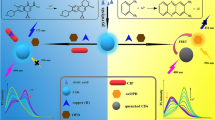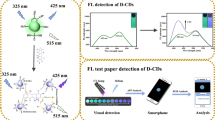Abstract
A novel colorimetric and ratiometric fluorescence sensor has been established based on boron carbon oxynitride quantum dots (BCNO QDs) and Ca2+ for the detection of doxycycline (DOX). BCNO QDs were synthesized by microwave-assisted method with boric acid and ethylenediamine. The fluorescence of BCNO QDs at 425 nm was quenched due to the electrostatic interaction and inner filter effect with doxycycline. Meanwhile, doxycycline was combined with Ca2+ to form a fluorescence complex, which generated a new fluorescence peak at 520 nm. The fluorescence intensity ratio (F520/F425) has a good linear relationship with doxycycline concentration, and the detection limit is 25 nM. Moreover, the fluorescence of the reaction solution showed a concentration-dependent visual color change from blue to green. In order to facilitate further application, a portable fluorescent test paper which is easy to store was prepared. The RGB values of the reaction solution and corresponding test paper were identified by smartphone, and the visual detection of doxycycline was performed by digital image colorimetric analysis. The application of smartphone and fluorescent test paper can effectively shorten the detection time and simplified the operation, providing an effective scheme for quantitative detection of doxycycline in actual samples. Overall, this work provides a method for the detection of doxycycline and shows that the BCNO QDs have great potential application in food safety.
Graphical abstract







Similar content being viewed by others
References
Kogawa A, Salgado H (2012) Doxycycline hyclate: a review of properties, applications and analytical methods. Int J Life Sci Pharma Res 2:11–25
Han QF, Zhao S, Zhang XR et al (2020) Distribution, combined pollution and risk assessment of antibiotics in typical marine aquaculture farms surrounding the Yellow Sea, North China. Environ Int 138:105551
Li N, Ho KWK, Ying GG, Deng WJ (2017) Veterinary antibiotics in food, drinking water, and the urine of preschool children in Hong Kong. Environ Int 108:246–252
Robles DT, Leonard JL, Compton N et al (2008) Severe drug hypersensitivity reaction in a young woman treated with doxycycline. Dermatology 217:23–26
Gajda A, Posyniak A, Tomczyk G (2014) LC-MS/MS analysis of doxycycline residues in chicken tissues after oral administration. Bull Vet Inst Pulawy 58:573–579
AlipanahpourDil E, Ghaedi M, Asfaram A et al (2020) A ferrofluidic hydrophobic deep eutectic solvent for the extraction of doxycycline from urine, blood plasma and milk samples prior to its determination by high-performance liquid chromatography-ultraviolet. J Chromatogr A 1613:460695
Abdulsattar JO, Hadi H, Richardson S et al (2020) Detection of doxycycline hyclate and oxymetazoline hydrochloride in pharmaceutical preparations via spectrophotometry and microfluidic paper-based analytical device (μPADs). Anal Chim Acta 1136:196–204
Ramesh PJ, Basavaiah K, Divya MR et al (2011) Simple UV and visible spectrophotometric methods for the determination of doxycycline hyclate in pharmaceuticals. J Anal Chem 66:482–489
Xie HZ, Dong C, Fen YL, Liu CS (1997) Determination of doxycycline, tetracycline and oxytetracycline simultaneously by TLC-Fluorescence scanning densitometry. Anal Lett 30:79–90
Xu Y, Ma B, Chen E et al (2020) Functional up-conversion nanoparticle-based immunochromatography assay for simultaneous and sensitive detection of residues of four tetracycline antibiotics in milk. Front Chem 8:1–12
Mu G, Liu H, Xu L et al (2012) Matrix solid-phase dispersion extraction and capillary electrophoresis determination of tetracycline residues in milk. Food Anal Methods 5:148–153
García-Campaña AM, Gámiz-Gracia L, Lara FJ et al (2009) Applications of capillary electrophoresis to the determination of antibiotics in food and environmental samples. Anal Bioanal Chem 395:967–986
Adrian J, Fernández F, Sánchez-Baeza F, Marco MP (2012) Preparation of antibodies and development of an enzyme-linked immunosorbent assay (ELISA) for the determination of doxycycline antibiotic in milk samples. J Agric Food Chem 60:3837–3846
Gao F, Zhao GX, Zhang HC et al (2013) Production of monoclonal antibody against doxycycline for immunoassay of seven tetracyclines in bovine muscle and milk. J Environ Sci Heal - Part B Pestic Food Contam Agric Wastes 48:92–100
Tian X, Fan Z (2021) Novel ratiometric probe based on the use of rare earth-carbon dots nanocomposite for the visual determination of doxycycline. Spectrochim Acta - Part A Mol Biomol Spectrosc 260:119925
Wei W, He J, Wang Y, Kong M (2019) Ratiometric method based on silicon nanodots and Eu3+ system for highly-sensitive detection of tetracyclines. Talanta 204:491–498
Xue Q, Zhang H, Zhu M et al (2016) Hydrothermal synthesis of blue-fluorescent monolayer BN and BCNO quantum dots for bio-imaging probes. RSC Adv 6:79090–79094
Zhu S, Song Y, Zhao X et al (2015) The photoluminescence mechanism in carbon dots (graphene quantum dots, carbon nanodots, and polymer dots): current state and future perspective. Nano Res 8:355–381
Jia X, Li L, Yu J et al (2018) Facile synthesis of BCNO quantum dots with applications for ion detection, chemosensor and fingerprint identification. Spectrochim Acta - Part A Mol Biomol Spectrosc 203:214–221
Rong M, Yang X, Huang L et al (2019) Hydrogen peroxide-assisted ultrasonic synthesis of BCNO QDs for anthrax biomarker detection. ACS Appl Mater Interfaces 11:2336–2343
Wu Z, Zhou Y, Huang H et al (2021) BCNO QDs and ROS synergistic oxidation effect on fluorescence enhancement sensing of tetracycline. Sensors Actuators B Chem 332:129530
Zhuang Y, Lin B, Yu Y et al (2021) A ratiometric fluorescent probe based on sulfur quantum dots and calcium ion for sensitive and visual detection of doxycycline in food. Food Chem 356:129720
Hussein W, Walker CG, Peralta-Inga Z, Murray JS (2001) Computed electrostatic potentials and average local ionization energies on the molecular surfaces of some tetracyclines. Int J Quantum Chem 82:160–169
Han S, Lian G, Zeng X et al (2020) Water-soluble boron carbon oxynitride dots with excellent solid-state fluorescence and ultralong room-temperature phosphorescence. Nano Res 13:3261–3267
Lei W, Mochalin VN, Liu D et al (2015) Boron nitride colloidal solutions, ultralight aerogels and freestanding membranes through one-step exfoliation and functionalization. Nat Commun 6:1–8
Zhang X, Lu Z, Liu H et al (2015) Blue emitting BCNO phosphors with high quantum yields. J Mater Chem C 3:3311–3317
Lei W, Portehault D, Dimova R, Antonietti M (2011) Boron carbon nitride nanostructures from salt melts: tunable water-soluble phosphors. J Am Chem Soc 133:7121–7127
Liu B, Yan S, Song Z et al (2016) One-step synthesis of boron nitride quantum dots: simple chemistry meets delicate nanotechnology. Chem - A Eur J 22:18899–18907
Leng F, Zhao XJ, Wang J, Li YF (2013) Visual detection of tetracycline antibiotics with the turned on fluorescence induced by a metal-organic coordination polymer. Talanta 107:396–401
Yu L, Chen H, Yue J et al (2020) Europium metal-organic framework for selective and sensitive detection of doxycycline based on fluorescence enhancement. Talanta 207:120297
Ramesh P, Basavaiah K, Rajendraprasad N (2010) Sensitive and selective spectrophotometric assay of doxycycline hyclate in pharmaceuticals using Folin-Ciocalteu reagent. Acta Pharm 60:445–454
Palamy S, Ruengsitagoon W (2017) A novel flow injection spectrophotometric method using plant extracts as green reagent for the determination of doxycycline. Spectrochim Acta - Part A Mol Biomol Spectrosc 171:200–206
Ashley J, Feng XT, Sun Y (2018) A multifunctional molecularly imprinted polymer-based biosensor for direct detection of doxycycline in food samples. Talanta 182:49–54
Su Q, Wei X, Mao J, Yang X (2019) Carbon nanopowder directed synthesis of carbon dots for sensing multiple targets. Colloids Surfaces A Physicochem Eng Asp 562:86–92
Fu X, Lv R, Su J et al (2018) A dual-emission nano-rod MOF equipped with carbon dots for visual detection of doxycycline and sensitive sensing of MnO4-. RSC Adv 8:4766–4772
Acknowledgements
This work was financially supported by National Natural Science Foundation of China (21707030) and Open Project Funding of the State Key Laboratory of Biocatalysis and Enzyme Engineering (SKLBEE2020017).
Author information
Authors and Affiliations
Corresponding author
Ethics declarations
Declaration of Competing Interest
The authors declare that they have no known competing financial interests or personal relationships that could have appeared to influence the work reported in this paper.
Additional information
Publisher's note
Springer Nature remains neutral with regard to jurisdictional claims in published maps and institutional affiliations.
Supplementary Information
Below is the link to the electronic supplementary material.
Rights and permissions
About this article
Cite this article
Liu, F., Wang, M., He, Y. et al. Smartphone-assisted ratiometric fluorescence sensing platform for the detection of doxycycline based on BCNO QDs and calcium ion. Microchim Acta 189, 113 (2022). https://doi.org/10.1007/s00604-022-05224-6
Received:
Accepted:
Published:
DOI: https://doi.org/10.1007/s00604-022-05224-6




